|
CLICK BUTTON TO GO |
|
|
|
|
|
|
|
|
|
|
|
|
|
Videos |
|
|
|
|
|
|
|
|
|
|
|
|
|
PART 1 T O P I C |
|
|
|
|
|
|
|
|
|
|
|
|
|
|
|
|
|
|
JewishWikipedia.info
WHITWELL MIDDLE SCHOOL, TENNESSEE, USA
THE PAPER CLIP MEMORIAL
For generations of
Whitwell students,
a paper clip will never again
be just a paper clip.
Instead, the paper clip is a reminder of the importance of
perseverance, empathy, tolerance and understanding.
THE PAPER CLIPS PROJECT
Wikipedia
The Paper Clips Project, by middle school students from the small southeastern Tennessee town of Whitwell, created a monument for the Holocaust victims of Nazi Germany. It started in 1998 as a simple 8th-grade project to study other cultures, and then evolved into one gaining worldwide attention. At last count, over 30 million paper clips had been received. Paper Clips, an award-winning documentary film about the project, was released in 2004 by Miramax Films.
DEVELOPMENT
In 1998, Linda M. Hooper, principal of Whitwell Middle School in Whitwell, Tennessee, asked Assistant Principal David Smith to find a voluntary after-school project to teach the children about tolerance. David Smith and Sandra Roberts started a Holocaust education program and held the first class in the fall of 1998. Soon the students were overwhelmed with the massive scale of the Holocaust and asked Mrs. Hooper if they could collect something to represent the lives that were exterminated during the Holocaust. Mrs. Hooper responded that they could if they could find something that related to the Holocaust or to World War II. Through Internet research, the students discovered that Johan Vaaler, a Norwegian, designed a loop of metal, and the Norwegians wore paperclips on their lapels during World War II as a silent protest against Nazi occupation. The students decided to collect 6,000,000 paper clips to represent the estimated 6,000,000 Jews killed between 1939 and 1945 under the authority of the Nazi government of Adolf Hitler.
At first the project went slowly, as it did not gain much publicity. Students created a website and sent out letters to friends, family and celebrities. The project began to snowball after it received attention from Peter and Dagmar Schroeder, journalists who were born in Germany during World War II and who covered the White House for German newspapers. They published some articles as well as a book, Das Büroklammer-Projekt (The Paper Clip Project) published in September 2000, that promoted the project in Germany. The big break in the US came with an article in the Washington Post on April 7, 2001, written by Dita Smith.
CITY OF WHITWELL
Almost all observers note the unexpected location of the project. The small rural town of Whitwell has about 1,600 residents and, according to the U.S. census, 97.35 percent of them are white. There was not a single Jew among the population of 425 students when the project began. Out of the 425 students that attend the school, there are only five African Americans and one Hispanic person.
About 40 miles away is the Rhea County Courthouse, where, in 1925, a teacher was convicted for teaching evolution during the Scopes "Monkey" Trial. The trial upheld a statute which outlawed teaching any theory that denies the Divine Creation. A hundred miles from Whitwell, in Pulaski, Tennessee, the infamous Ku Klux Klan was reportedly born.
The city is quite poor, as its main business, coal mining, started to decline after an accident 30 years ago; the last mine was shut down completely in 1997. About half of the students at the middle school qualify for the free lunch program, which is a benefit for lower-income American school children.
PAPER CLIPS
Paper clips were chosen in part because Norwegians wore them on their lapels as a symbol of resistance against Nazi occupation during World War II (Norwegian Johan Vaaler is often credited with the invention of a progenitor of the modern paper clip.)
The paper clips were sent by various people by mail; the letters came from about 20 different countries. Some celebrities, like George W. Bush, Bill Clinton, Bill Cosby , Steven Spielberg, Tom Bosley and Tom Hanks were among those mailing in the clips. As of the summer of 2004, the school had collected about 24 million paper clips. As of 2005, more were still coming in. Most letters contain a story or a dedication of the attached paper clips to a certain person. Some of these stories are shared in the film.
MONUMENT
The Children's Holocaust Memorial consists of an authentic German transport car (which arrived in the Baltimore seaport on September 9, 2001) surrounded by a small garden. The railcar is filled with 11 million paper clips (6 million for murdered Jews and 5 million for Roma, Catholics, homosexuals, Jehovah's Witnesses, and other groups). The monument was uncovered on the anniversary of the Kristallnacht, November 9, 2001.
Linda Pickett sculpted eighteen butterflies of twisted copper which are embedded in concrete around the railcar. Butterflies came from a poem written by a child who lived in Terezin concentration camp in 1942 (I Never Saw Another Butterfly) and the number 18 in Hebrew symbolizes life (in Gematria, 18 is the numerical value of the word חי, pronounced Chai, meaning life). Inside the railcar, besides the paper clips, there are the Schroeders’ book and a suitcase filled with letters of apology to Anne Frank by a class of German schoolchildren.
A sculpture designed by an artist from Ooltewah, Tennessee stands next to the car, memorializing the 1.5 million children murdered by the Nazis, and incorporating another 11 million paper clips.
RIDE TO REMEMBER
In 2006 the Jewish Motorcyclists Alliance and Yidden on Wheels, a Toronto-based Jewish motorcycle club, organized a ride from points across North America to Whitwell, TN to commemorate the Paperclip Project and in honor of the Holocaust's victims. The ride was also a fundraiser for that school, with over $35,000 raised to help the school buy interactive blackboards.
Mitchell Belman, a Toronto-based filmmaker, captured the essence of this ride in his documentary Paper Clips: A Ride to Remember
BUTTON COLLECTION
Moriah School, a little school of 28 students in Wellington, New Zealand, is collecting one button for every child who died in the Holocaust - this means we need 1.5 million buttons! We are going to create a memorial sculpture to remember the lost children.
We are a little school, we only have 28 students from 5 years old to 12 year olds. We are the only Jewish state-integrated school in New Zealand. We learn all of the same curriculum as other New Zealand schools, but we also have extra classes in Hebrew and Jewish studies. Our school is in the middle of the city so we don't have much playground, but we visit Te Papa, a very cool museum, and we go to parks and swimming pools. We started this blog because we need to get more buttons for our Holocaust project. So far we have learnt about the Holocaust, talked to a survivor, studied memorials around the world and we just reached our 400,000 button mark. On this blog we have put pictures of our artwork, our designs for the memorial sculpture and some other stuff we have done..
The button collection was transferred to
the Holocaust Center of New Zealand below.
HOLOCAUST CENTER OF NEW ZEALAND
THE CHILDREN'S HOLOCAUST MEMORIAL - THE BUTTON MEMORIAL
Holocaust Center of New Zealand

The Germans and their collaborators killed as many as 1.5 million children. This included over a million Jewish children and tens of thousands of Romani (Gypsy) children, German children with physical and mental disabilities living in institutions, Polish children and children residing in the occupied Soviet Union.
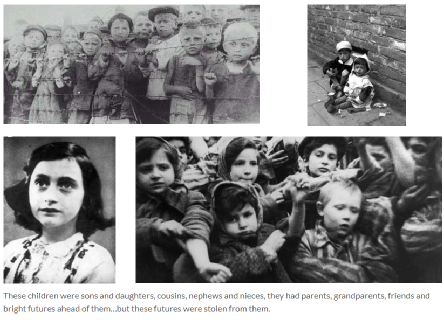
These children were sons and daughters, cousins, nephews and nieces, they had parents, grandparents, friends and bright futures ahead of them…but these futures were stolen from them.
When Justine Hitchcock (Principal of Wellington’s Moriah Jewish Day School) was teaching her young pupils about the Holocaust she decided to help the children understand the enormity of 1.5 million children being murdered by initiating a project whereby they would collect 1.5 million buttons - one button for each child that perished. The children themselves managed the project. No child was more than 12 years old.
Buttons were sent in from the local Wellington community, from across New Zealand and even from overseas. Many buttons came with personal stories and photographs.
The project evolved into a story of collective remembrance.
Through its support of the project, the wider New Zealand community and many other communities throughout the world, showed this small group of students that
the life of a child truly counts.
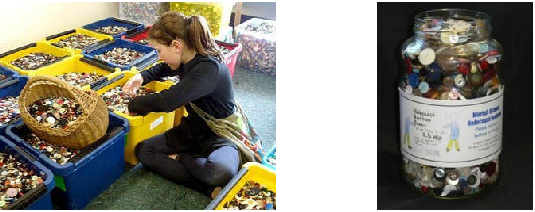
Buttons were collected, cleaned and counted by the children of Moriah School over a two-year period - each representing the loss of a child during the Holocaust. When understood as a whole, the project conveys a powerful, poignant and disturbing message: one of loss that is simply unfathomable.
BUTTONS
- Each one unique, as indeed a child is unique.
- Each one circular, representing the circle of life
- Buttons - hold clothes together - as a child can hold a family together.
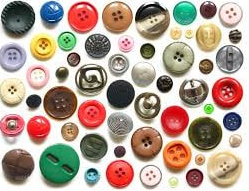
Some of the 1,500 buttons collected at the National Army Museum
for the Moriah School Holocaust Memorial (2010)
Ex-Moriah school pupil, Benya Klaupaukh, recalls his learnings from primary school, when he was a founding student in the Moriah button collection:
“My primary school was very small, with only 20 pupils. At my school we were learning about the Holocaust and one fact we came across was that 1.5 million Jewish children were murdered. Our principal wanted to make me and my fellow students understand the magnitude of this number, so we began our project, New Zealand Children’s Holocaust Memorial, collecting 1.5 million buttons, one for each child that perished in the Holocaust. So, 20 children, no older than 12 years old were supposed to collect and count 1.5 million buttons. This even to me, looking back sounds completely ridiculous, that’s 50,000 buttons per student. However crazy we thought this idea was, we never gave up, we never stopped making posters, we never stopped telling people about our ‘ambitious’ project, and we never stopped counting the buttons that were pouring in. “
The significance of the Moriah Button Project was recognised by featuring in a 2012 edition of the New Zealand School Journal, and being used as an illustration for National Standards in Reading (Yr 7).
When Moriah school closed in 2012, the button collection and plans for a memorial were entrusted to the Holocaust Centre of New Zealand (“HCNZ”).
MEMORIAL & SUPPORTERS
The Patrons of the Children’s Holocaust Memorial project were British humanitarian, Sir Nicholas Winton (who saved the lives of 669 mostly Jewish children by organising their evacuation in trains from Czechoslovakia to the UK during 1939), and acclaimed New Zealand author of children’s literature, Dame Joy Cowley. Sir Nicholas passed away in 2015 before the project could be completed, but Dame Joy Cowley continues as Project Patron.
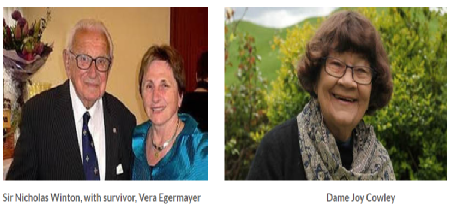
Sir Nicholas Winton,
with survivor, Vera Egermayer
Dame Joy Cowley
Other notable supporters include:
Czech-Israeli painter Chava Pressburger whose brother died in Auschwitz. http://www.centropa.org/biography/chava-pressburger
French historian, Serge Klarsfeld, who retrieved photos of over 4,000 of the 11,400 French Jewish children murdered by the Nazis. He created a paper memorial for them in the form of a photo gallery located in the Memorial of the Shoah in Paris. http://www.jewishvirtuallibrary.org/serge-klarsfeld
Dagmar Liblova, a Czech survivor of Auschwitz donated 4 buttons for her family members to symbolise the 15,000 Czech Jewish children who perished. She has been decorated for her lifetime service to keeping the memory alive through teaching, writing and presiding over a survivor organisation, the Terezin Initiative. http://www.pametnaroda.cz/witness/index/id/1256/
Former New Zealand Prime Minister, Rt.Hon John Key
Former Wellington City Council Mayor, Celia Wade-Brown.
BUTTON MEMORIAL DESIGN
When Moriah School closed in December 2012, the button collection and plans for a Memorial were entrusted to the Holocaust Centre of New Zealand (“HCNZ”).
The original memorial design, entitled ‘Bewilderment’, was a cube-like building housing a maze with walls filled with buttons and a central candle sculpture including a simple plaque quoting Wellington-based Holocaust child survivor, Vera Egermayer: “In a time like the Holocaust it is like living in a pitch-black room, but every time someone does something nice for you, it’s like them coming in the room and lighting a candle. You need to focus on the light”.
Unfortunately, this design was not feasible and a site was never secured.
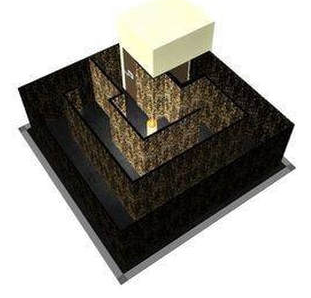
A NEW DESIGN
In 2017, a Committee was formed to ensure that the Memorial would be realised and the children’s efforts brought to fruition. The Committee includes ex-Moriah school pupils, child survivors of the Holocaust and HCNZ Directors.
A new design concept was facilitated by Assistant Head and Lecturer from the Massey School of Design, Matthijs Siljee. His design captures the original intention of representing each child and conveying the unimaginable scale of 1.5 million lives. Rather than a permanent installation in Wellington, the Memorial has been designed to travel throughout New Zealand and be accessible to as many people as possible.
The design begins with a single box on wheels containing a single light; the next box, containing a single button denoting a single child/a single life. As the boxes on wheels grow in size, each unit contains more buttons - representing a family, a class, a school, a city – and each growing in height of container and number of buttons. The tallest unit containing buttons will deliberately tower over viewers, enabling them to reflect on the scale of The Holocaust and the 1.5 million innocent murdered children.
EDUCATION
The Children’s Holocaust Memorial is accompanied with an exhibition of panels containing photographs and details of some of the young lives stolen, many being children that have connections to Holocaust survivors and descendants living in New Zealand. Alongside this are contemporary panels with the message of being an Upstander rather than a bystander.
For more information on the educational components, to access teaching resources and for details on booking in a school or adult group for a guided educational session with members of our educational team go to this page: https://www.holocaustcentre.org.nz/childrens-holocaust-memorial1.html
HISTORICAL & KEY LINKS
http://old.radio.cz/mp3/podcast/en/panorama/holocaust-survivor-vera-egermayer-telling-children-my-story-helped-me-understand-my-own-life.mp3
Vera Egermayer, child survivor of Terezin concentration camp and champion of the Children’s Holocaust Memorial interview, Radio Prague, 23.5.2013
https://www.youtube.com/watch?v=fOB8ln6PrQM
TV 3 News, July 2 2010
https://www.youtube.com/watch?v=SjN0Zlm9pqU
Vera Egermayer talks about the New Zealand Children's Holocaust
Memorial.https://www.youtube.com/watch?v=kNRDyjEIH5Y
Wellington Morah School Button Project
http://hmd.org.uk/resources/stories/%E2%80%986-million-%E2%80%99-%E2%80%93-button-memorial
The 6 million+ Memorial - Permanent structure in Yorkshire
THE LAKES SCHOOL, WINDERMERE,
AN IDEA AS BRIGHT AS SIX MILLION BUTTONS
The Lakes School
Francine Wolfisz finds out about B's Buttons,
a student project to create a memorial
to the 1.5 million Jewish children murdered in the Shoah
Jewish News, Francine Wolfisz, April 11, 2018
What does six million look like? While one inquisitive student learning about the horrors of the Holocaust had asked a seemingly straightforward question, for her teacher the answer was far from simple.
Laura Oram, a history teacher at The Lakes School in Windermere, Cumbria, had tasked her pupils with designing a meaningful memorial to the Jews killed at the hands of Nazi persecution during the Second World War, having been inspired by a visit from Holocaust survivor Arek Hersh.
He was one of 732 displaced children, known collectively as “The Boys”, who were resettled in the UK in 1945.
Arek and 299 others were given a new home on the Calgarth Estate in the Lake District, a wartime housing scheme built for aviation workers, where The Lakes School now resides.
As they mulled over finding the solution, the 29-year-old teacher and her student, Bliss, also known as “B”, came up with the idea of collecting buttons.
.We discovered a similar project, 6 million +, had been devised more than ten years ago, Our focus changed to concentrate on the 1.5 million murdered children
B’s Buttons is a project inspired by pupils at The Lakes School, Windermere, to create a memorial to the 1.5 million Jewish children murdered in the Shoah
Since launching in September, the project – known as B’s Buttons – has fired the imagination of people around the globe and collected more than 300,000 buttons, with contributions coming from the US, Canada, Mexico, the Caribbean, Australia, New Zealand, Poland, France and the UK.
“When one of our students asked what six million looked like, I didn’t have an answer,” explains Laura. “It’s difficult even for adults to conceptualise. You can imagine 30,000 people in a football stadium, but beyond that is tricky.
“B came up with the idea of buttons and perceptively noted that they are all different shapes and sizes, just like the children they represent.
“When we started, I assumed we would collect some buttons and do something small. But when I put the post on Facebook, it just took off. All these buttons started arriving.”
Poignantly, many contributors include letters detailing how they or their close relative survived the Holocaust.
One package contained the buttons taken from the coat of a young child sent on the Kindertransport.
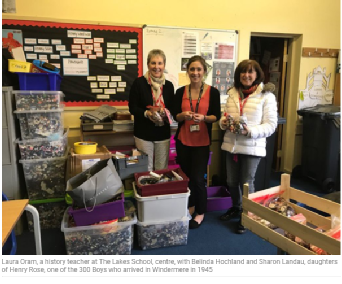 Trevor Avery, director of the Lake District Holocaust Project, who has been assisting the school in their efforts, described the letters as “moving and incredible”.
Trevor Avery, director of the Lake District Holocaust Project, who has been assisting the school in their efforts, described the letters as “moving and incredible”.
Laura Oram, a history teacher at The Lakes School, centre, with Belinda Hochland and Sharon Landau, daughters of Henry Rose, one of the 300 Boys who arrived in Windermere in 1945
He said: “One daughter of a Holocaust survivor decided to send one of her mum’s buttons.
“Another, whose mother was one of the youngest to arrive at Windermere aged just four, sent all her little buttons in.
“There was also a woman from the US who sent all her father’s buttons from his army tunic and Sandhurst College sent a beautiful collection, a button from every regiment that has ever passed through.
“My mother died four years ago and we’ve even contributed her button collection. A lot of people have put their emotions and heart into this.”
In the wake of February’s deadly mass shooting at a secondary school, a group in Parkland, Florida collected 14,738 buttons – a testimony, says Avery, to how B’s Buttons has touched people around the world and is seen as “a positive commemoration to the children who lost their lives and a determination to remember them.”
The venture was given another boost in recent months thanks to Abigail Mann, a solicitor from St Albans, who heard about the project and wanted to help spread the word to the Jewish community around the UK.
Her efforts have helped set up button collections at museums, schools and synagogues, including at The Wiener Library and The Radlett Centre.
Now the great task of counting the buttons lies ahead, with Bushey United Synagogue, Stanmore and Canons Park Synagogue and Thames Valley Limmud among those planning counts in the weeks ahead.
The idea also inspired mum-of-three Gabi Rolfe, from Bushey, to get a collection started at Hertsmere Jewish Primary School, in Radlett, which her children attend.
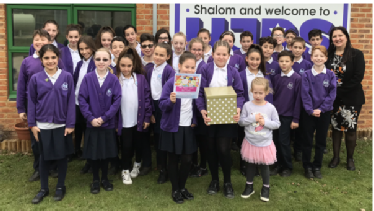
Hertsmere Jewish Primary School acting head Rita Alak-Levy with Year 4, Year 6 and Reception pupils with their collection for B’s Buttons
“I found it even more poignant that this was started by children at a non-Jewish school, who wanted to do everything they could to honour the Jewish children who were murdered.
“Because the project is so visual, the children can better understand the enormity of what happened during the Holocaust. It’s just an amazing idea.”
Andy Cunningham, headteacher at The Lakes School, said the school had been “overwhelmed” by how the project has taken root around the world and wanted to thank those who had donated buttons in helping to “realise a young person’s vision”.
He added: “B’s buttons is an amazing project and it’s true to say that we have been overwhelmed by the public response.
“Buttons have been arriving in our school from far and wide and we have been touched by some of the personal messages from people moved by the project.”
The hope is that once 1.5 million buttons are collected, they will be turned into a permanent Holocaust memorial sited on the school grounds, next to a sapling brought from Auschwitz that was planted in the school gardens last year.
You can donate your buttons at The Wiener Library for the Study of the Holocaust & Genocide in Russell Square, London and the Radlett Centre, Aldenham Avenue, Radlett.
For more information about B’s Buttons,
email [email protected] or visit facebook.com/lakesbuttons/
HOLOCAUST BUTTONS PROJECT
REACHES MAJOR MILESTONE
The Westmoreland Gazette,
Mike Addison, Assistant Editor, 19 July 2018
A Lake District school has collected more than a million buttons as part of an ongoing project to commemorate the estimated 1.5 million children murdered during the Holocaust.
The Lakes School at Troutbeck Bridge, near Windermere, launched its memorial campaign, ‘B’s Buttons’, late last year following a visit from Jewish Holocaust survivor Arek Hersh.
Hersh was among the 300 children, known collectively as ‘the Windermere Boys’, who found refuge at the Calgarth Estate in 1945. This site is currently home to the Lakes School.
Following Mr Hersh’s visit, history teacher Laura Oram invited students to design a memorial to those killed. A year 10 student suggested buttons be collected to represent each child that perished.
Ms Oram told The Westmorland Gazette that children cheered when it was announced on Monday that they had surpassed the million buttons milestone.
She estimated that the Lakes School has already received the 1.5 million buttons required to reach its goal, however many remain to be counted.
In fact, with more than eight pallets filled with buttons collected in synagogues across London and St Albans and still to be delivered to the school, she speculated they may even gather double the amount of buttons required for the project.
“People from all over the world have been keen to contribute,” Ms Oram said, with communities in countries including Australia, Mexico, Israel and the USA donating to the memorial.
Among the largest donors is a Women’s Institute in the Isle of Man, which donated approximately 93,000 buttons.
A community group in Parkland, Florida, also contributed around 26,000 buttons, a donation Ms Oram described as “very poignant” in the wake of the school shooting which claimed 17 lives in February.
Although organised prior to the shooting by the daughter of one of ‘the Windermere Boys’, the collection and counting continued even after the tragedy, seeing members of the local community come together to commemorate young lives lost.
THE SAMUEL E SHULL MIDDLE SCHOOL
Perth Amboy, NJ, USA 2017
SOLE WITNESS,
A HOLOCAUST PROJECT
by the
STUDENTS OF SAMUEL E. SHULL SCHOOL
Rachel Wintemberg 2017 (12.58)
1.5 Million Children died in the Holocaust.
Gypsies, Jews, Jehovah Witnesses, Polish Children,
disabled children, children with epilepsy, children with autism.
What might they have done with their lives
had they had a chance to grow up?
What diseases might they have cured?
What novels might they have written?
Let us pull their shoes out from the pile of anonymity
and use our imagination to explore that question through our artwork.
For the complete art lesson, please visit my blog at http://thehelpfulartteacher.blogspot....
HOW BIG IS SIX MILLION?
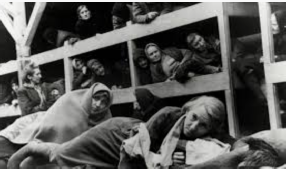
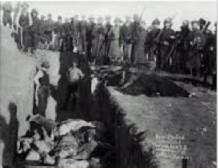
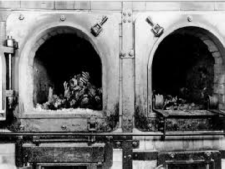
THE
INCREDIBLE
STORY OF THE JEWISH PEOPLE
Whitwell Middle School Holocaust Memorial:
Paper Clips
brandylu100 2011 (5.00)
Paper Clip Project
at Whitwell Middle School
WDEF News 12 2018 (2.36)
20 years ago, a teacher began a Holocaust memorial for kids with the Paper Clip Project. We go back to Whitwell for the 20th anniversary for our What's Right With Our Schools episode.
The Paperclip Project -
Holocaust Memorial
inspirationandspirit 2011 (3.06)
After hearing a Holocaust survivor speak at a teacher training conference, David Smith, and other teachers created the Whitwell Middle School Holocaust Project, a curriculum about issues of hate and intolerance. The project expanded to the creation of a Holocaust memorial, and became the subject of a
documentary film, "Paper Clips,"
and a book, "Six Million Paper Clips:
The Making Of A Children's Holocaust Memorial."
CHILDRENS
PAPERCLIP HOLOCAUST MEMORIAL
Andy's Journeys 2017 (19.57)
A sad and moving project started in 1998 by the Whitwell Middle school.
An authentic German Railcar filled with 11 million paperclips.
Well worth the detour to check out
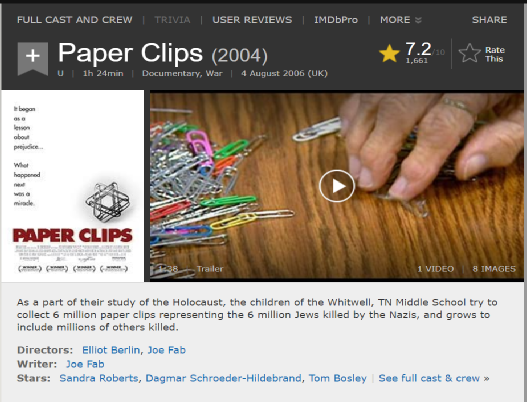
MORIAH SCHOOL BUTTON MEMORIAL
JustineHitchl 2010 (4.52)
Moriah School has spent two years collecting 1.5 million buttons - thats one button for every child who died in the Holocaust. They have now designed a memorial sculpture that uses the buttons in the walls of a maze. In this video the children talk about thier project and show a computer image
of their memorial design.
